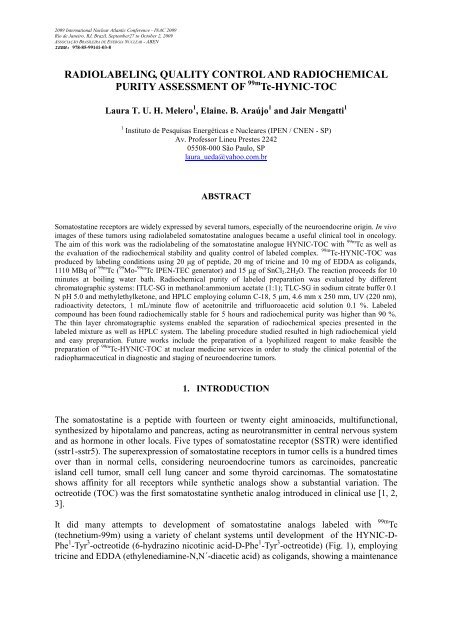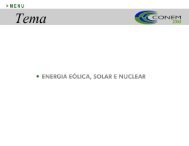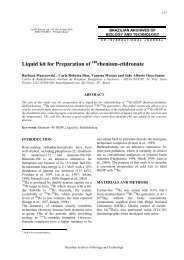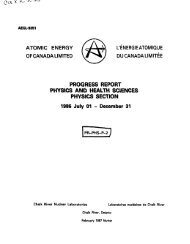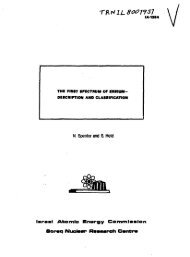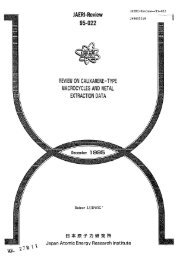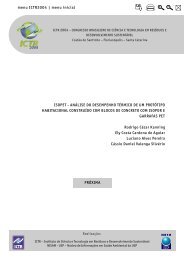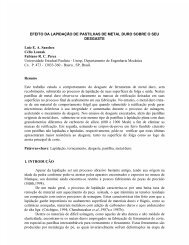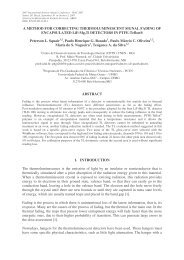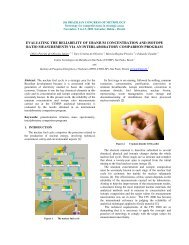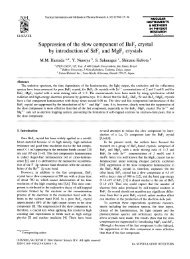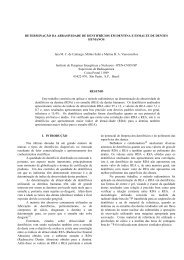Full text ENAN E08 - Ipen
Full text ENAN E08 - Ipen
Full text ENAN E08 - Ipen
You also want an ePaper? Increase the reach of your titles
YUMPU automatically turns print PDFs into web optimized ePapers that Google loves.
2009 International Nuclear Atlantic Conference - INAC 2009<br />
Rio de Janeiro, RJ, Brazil, September27 to October 2, 2009<br />
ASSOCIAÇÃO BRASILEIRA DE ENERGIA NUCLEAR - ABEN<br />
ISBN: 978-85-99141-03-8<br />
RADIOLABELING, QUALITY CONTROL AND RADIOCHEMICAL<br />
PURITY ASSESSMENT OF 99m Tc-HYNIC-TOC<br />
Laura T. U. H. Melero 1 , Elaine. B. Araújo 1 and Jair Mengatti 1<br />
1 Instituto de Pesquisas Energéticas e Nucleares (IPEN / CNEN - SP)<br />
Av. Professor Lineu Prestes 2242<br />
05508-000 São Paulo, SP<br />
laura_ueda@yahoo.com.br<br />
ABSTRACT<br />
Somatostatine receptors are widely expressed by several tumors, especially of the neuroendocrine origin. In vivo<br />
images of these tumors using radiolabeled somatostatine analogues became a useful clinical tool in oncology.<br />
The aim of this work was the radiolabeling of the somatostatine analogue HYNIC-TOC with 99m Tc as well as<br />
the evaluation of the radiochemical stability and quality control of labeled complex. 99m Tc-HYNIC-TOC was<br />
produced by labeling conditions using 20 µg of peptide, 20 mg of tricine and 10 mg of EDDA as coligands,<br />
1110 MBq of 99m Tc ( 99 Mo- 99m Tc IPEN-TEC generator) and 15 µg of SnCl2.2H2O. The reaction proceeds for 10<br />
minutes at boiling water bath. Radiochemical purity of labeled preparation was evaluated by different<br />
chromatographic systems: ITLC-SG in methanol:ammonium acetate (1:1); TLC-SG in sodium citrate buffer 0.1<br />
N pH 5.0 and methylethylketone, and HPLC employing column C-18, 5 µm, 4.6 mm x 250 mm, UV (220 nm),<br />
radioactivity detectors, 1 mL/minute flow of acetonitrile and trifluoroacetic acid solution 0.1 %. Labeled<br />
compound has been found radiochemically stable for 5 hours and radiochemical purity was higher than 90 %.<br />
The thin layer chromatographic systems enabled the separation of radiochemical species presented in the<br />
labeled mixture as well as HPLC system. The labeling procedure studied resulted in high radiochemical yield<br />
and easy preparation. Future works include the preparation of a lyophilized reagent to make feasible the<br />
preparation of 99m Tc-HYNIC-TOC at nuclear medicine services in order to study the clinical potential of the<br />
radiopharmaceutical in diagnostic and staging of neuroendocrine tumors.<br />
1. INTRODUCTION<br />
The somatostatine is a peptide with fourteen or twenty eight aminoacids, multifunctional,<br />
synthesized by hipotalamo and pancreas, acting as neurotransmitter in central nervous system<br />
and as hormone in other locals. Five types of somatostatine receptor (SSTR) were identified<br />
(sstr1-sstr5). The superexpression of somatostatine receptors in tumor cells is a hundred times<br />
over than in normal cells, considering neuroendocrine tumors as carcinoides, pancreatic<br />
island cell tumor, small cell lung cancer and some thyroid carcinomas. The somatostatine<br />
shows affinity for all receptors while synthetic analogs show a substantial variation. The<br />
octreotide (TOC) was the first somatostatine synthetic analog introduced in clinical use [1, 2,<br />
3].<br />
It did many attempts to development of somatostatine analogs labeled with 99m Tc<br />
(technetium-99m) using a variety of chelant systems until development of the HYNIC-D-<br />
Phe 1 -Tyr 3 -octreotide (6-hydrazino nicotinic acid-D-Phe 1 -Tyr 3 -octreotide) (Fig. 1), employing<br />
tricine and EDDA (ethylenediamine-N,N´-diacetic acid) as coligands, showing a maintenance
of in vivo affinity in rats brain cortex membranes and promising patterns of biodistribution in<br />
vivo in animals with induced tumors, and high like tumor-kidney and tumor-live relation [4].<br />
The imaging of neuroendocrine tumors has become one of the most significant areas in<br />
nuclear oncology. Imaging with 99m Tc-HYNIC-TOC showed a greater tumor-to-nontumor<br />
ratio and greater uptake. Decristoforo et al. compared the clinical efficacy of 99m Tc-HYNIC-<br />
TOC for adequate imaging with commercially available 111 In-DTPA-octreotide in patients<br />
with various neuroendocrine tumors and found that the 99m Tc labeled TOC had higher tumorto-background<br />
ratios and provided superior scans [5, 6].<br />
INAC 2009, Rio de Janeiro, RJ, Brazil.<br />
Figure 1. HYNIC-octreotide structure 8<br />
About 80 % of the radiopharmaceuticals used in nuclear medicine are 99m Tc labeled<br />
compounds commercially available and prepared with 99m Tc from 99 Mo- 99m Tc (molibdenium-<br />
99-technetium-99m) generators with low cost. The 99m Tc shows favorable characteristics for<br />
application in diagnostic procedures: 6 hours of short half-life, gamma rays emission of 140<br />
keV ideal for scintigraphy images proceedings in gamma chamber or in SPECT (Single<br />
Photon Emission Computed Tomography) in nuclear medicine and no particulate emission [7,<br />
8].<br />
The aim of this study was the radiolabeling of the somatostatine analogue HYNIC-TOC with<br />
99m Tc as well as the evaluation of the radiochemical stability of labeled complex.<br />
2.1. Reagents and solvents<br />
2. MATERIAL AND METHODS<br />
All reagents employed were purchased from Sigma-Aldrich in high pure grade. Sodium<br />
pertecnetate solution was obtained from IPEN-TEC 99 Mo- 99m Tc generator (IPEN-CNEN/SP)<br />
and HYNIC-octreotide was obtained from Pichem.
2.2. Labeling protocol<br />
In the reaction vial 20 μg of HYNIC-TOC in ethanol 10 % was introduced followed by 10<br />
mg of EDDA in NaOH 0.1 N, 20 mg of tricine in sodium phosphate buffer 0.2 N pH 6.2,<br />
1110 MBq (30 mCi) of 99m TcO4 - , 15 μg of SnCl2.2H2O in HCl 0.1 N and the reaction mixture<br />
was heated in boiling water bath for 10 minutes [8, 9, 10, 11].<br />
2.3. Quality control of 99m Tc-HYNIC-TOC<br />
Radiochemical purity analysis was assessed with two different chromatographic approaches:<br />
High Performance Liquid Chromatography (HPLC) and Thin Layer Chromatography (TLC),<br />
using silica gel plates (TLC-SG and ITLC-SG). HPLC technique was used also to validate<br />
TLC approach.<br />
The radiochemical purity of 99m Tc-HYNIC-TOC were determined by HPLC with reversed<br />
phase C18 column (4.6 mm x 250 mm) using ACN/0.1 % TFA gradient as a mobile phase at a<br />
1 mL/min flow rate. 99m Tc-HYNIC-TOC was monitored by radioactivity detector and UV<br />
detector (220 nm).<br />
The radiochemical purity of 99m Tc-HYNIC-TOC determined by ITLC-SG and TLC-SG strips,<br />
employed methanol:ammonium acetate (1:1), methylethylketone and sodium citrate buffer<br />
0.1 N pH 5.0 as a mobile phase. Strips were analyzed by gamma counter (Table 1).<br />
Table 1. Chromatographic system and relation front (Rf) of radiochemical species<br />
Radiochemical species Stationary phase Mobile phase Rf<br />
99m<br />
TcO4 - 99m<br />
TcO2<br />
99m<br />
Tc-coligand<br />
TLC-SG Sodium citrate buffer 0.1 N pH 5.0<br />
1<br />
0<br />
1<br />
99m<br />
Tc-HYNIC-TOC<br />
0<br />
99m<br />
TcO4 - 99m<br />
TcO2<br />
99m<br />
Tc-coligand<br />
TLC-SG Methylethylketone<br />
1<br />
0<br />
0<br />
99m<br />
Tc-HYNIC-TOC<br />
0<br />
99m<br />
TcO4 - 1<br />
99m<br />
TcO2<br />
99m<br />
Tc-coligand<br />
ITLC-SG Methanol:ammonium acetate (1:1)<br />
0<br />
1<br />
1<br />
99m Tc-HYNIC-TOC<br />
The percentage of labeled peptide ( 99m Tc-HYNIC-TOC) as well as the percentage of<br />
radiochemical impurities were determined in TLC systems, considering the sum of segments<br />
in the chromatographic strips as showed in Fig. 2.<br />
INAC 2009, Rio de Janeiro, RJ, Brazil.
Figure 2. Chromatographic strip representation utilized in radiochemical purity control<br />
with cutting marks<br />
All experiments were performed in duplicate, it means, two chromatographic strips to each<br />
mobile phase.<br />
In order to check the stability of the preparation, radiochemical purity of the labeling<br />
mixtures were determined (N= 6), 30 minutes and 5 hours after labeling procedure.<br />
INAC 2009, Rio de Janeiro, RJ, Brazil.<br />
3. RESULTS<br />
The employed labeling procedure resulted in high radiochemical yield that means, the<br />
percentage of the 99m Tc-HYNIC-TOC in the preparation were superior than 90 %, when<br />
determined by TLC.<br />
HPLC chromatograms did not show any changes in radiochemical purity during the time<br />
course considered for the analysis and the values were higher than 90 %. Retention time of<br />
99m Tc-HYNIC-TOC was 13.17 minutes, while free 99m Tc was eluted at 3.25 minutes (Fig. 3).<br />
The HPLC system also identified the 99m Tc-coligand, a radiochemical impurity that can be<br />
identified in the preparation (RT= 4.57) (Fig. 3).
B<br />
Figure 3. HPLC chromatograms of (A) 99m Tc-HYNIC-TOC, (B) 99m TcO4 - and 99m Tccoligand<br />
Table 2 represents the percentage of the 99m Tc-HYNIC-TOC in five preparations, 30 minutes<br />
and 5 hours after labeling procedure.<br />
INAC 2009, Rio de Janeiro, RJ, Brazil.<br />
A<br />
Table 2. Radiochemical yield distribution of each labeling procedure<br />
% 99m Labeling procedure<br />
Tc-HYNIC-TOC<br />
30 min 5 h<br />
1 94.20 ± 0.1 93.92 ± 0.1<br />
2 94.86 ± 0.1 96.28 ± 0.1<br />
3 90.88 ± 3.61 93.71 ± 1.35<br />
4 90.94 ± 1.06 92.26 ± 0.20
INAC 2009, Rio de Janeiro, RJ, Brazil.<br />
% 99m Labeling procedure<br />
Tc-HYNIC-TOC<br />
30 min 5 h<br />
5 92.01 ± 0.99 90.66 ± 0.52<br />
Average 93.58 ± 1.85 93.36 ± 2.09<br />
The high stability of labeled peptide can be also evidenced on Fig. 4.<br />
Radiochemical Yield (%)<br />
100,00<br />
80,00<br />
60,00<br />
40,00<br />
20,00<br />
0,00<br />
0 1 2 3 4 5 6<br />
Labeling procedure<br />
Figure 4. Radiochemical yield distribution of 5 radiolabeling sessions<br />
30 min<br />
The mean percentage of the different radiochemical impurities presented in the five<br />
preparations can be evidenced on Table 3<br />
N° of labeling<br />
5<br />
Table 3. Radiochemical yield distribution of 5 preparations<br />
Average yield (%) Range of yield (%)<br />
Radiochemical species 30 min 5 hours 30 min 5 hours<br />
99m<br />
TcO4 - 0.54 ± 0.40 3.45 ± 4.11<br />
99m<br />
TcO4 - + 99m Tc-coligand 7.29 ± 3.62 7.92 ± 5.42<br />
99m<br />
Tc-coligand 6.75 ± 3.31 4.48 ± 1.81<br />
99m<br />
TcO2 1.54 ± 1.22 0.82 ± 0.49<br />
99m<br />
Tc-HYNIC-TOC 91.17 ± 3.83 91.25 ± 5.50 90.88 – 94.86 90.66 – 96.28<br />
5 h
The pH value of the product, measured by pH strip, was about 6.5.<br />
INAC 2009, Rio de Janeiro, RJ, Brazil.<br />
4. DISCUSSION<br />
The proposed method for the labeling of HYNIC-TOC with 99m Tc was demonstrated to be<br />
reliable and reproducible, with high radiochemical yield and low cost in the routine practice,<br />
especially if compared with 111 In-DTPA-octreotide that is now used in routine procedures for<br />
diagnostic and staging of neuroendocrine tumors.<br />
The good radiochemical yield and stability of the peptide labeled with technetium stimulate<br />
future works for development of a lyophilized reagent that enable routine utilization.<br />
Radio HPLC and TLC-SG methods had shown comparable results: radiochemical purity was<br />
higher than 90 % and the product remained stable during 5 hours.<br />
Because TLC is an easier and faster protocol widely used in the nuclear medicine department,<br />
the HPLC validation described in this paper allows the use of this approach for routine<br />
application in the quality control of this radiopharmaceutical.<br />
5. CONCLUSIONS<br />
We can conclude that 99m Tc- HYNIC-TOC represents a reliable tool for routine clinical<br />
application in the diagnostic of neuroendocrine tumors instead of 111 In labeled peptide.<br />
REFERENCES<br />
1. E. R. Obenaus, J. L. Crudo, M. M. Edreira, S. G. Castiglia, “Analogos de somatostatina<br />
99m<br />
marcados con Tc,” Ver. Med. Nucl. Alasbimn J., Santiago,<br />
http://www.alasbimnjournal.cl/19obenaus.html (2003).<br />
2. Q. Wang, K. Graham, T. Schauer, T. Fietz, A. Mohamed, X. Liu, J. Hoffend, U.<br />
Haberkorn, M. Eisenhut, W. Mier, “Pharmacological properties of hydrophilic and<br />
lipophilic derivatives of Octreotate,” Nucl. Med. Biol., v. 31, pp. 21-30 (2004).<br />
3. A. Placcińska, R. Mikolajczak, H. R. Maecke, E. Mlodkowska, J. Kunert-Radek, A.<br />
Michalski, K. Rzeszutek, J. Kozak, J. Kuśmierek, “Clinical usefulness of 99mTc-<br />
EDDA/HYNIC-TOC scintigraphy in oncological diagnostics: a preliminary<br />
communication,” Eur. J. Nucl. Med. Mol. Imaging, v. 30, n. 10, pp. 1402-1406 (2003).<br />
4. M. Bangard, M. Béhé, S. Guhlke, R. Otte, H. Bender, H. R. Maecke, H. J. Biersak,<br />
“Detection of somatostatin receptor-positive tumours using the new 99mTc-tricine-<br />
HYNIC-D-Phe1-Tyr3-octreotide: first results in patients and comparison with 111In-<br />
DTPA-D-Phe1-octreotide,” Eur. J. Nucl. Med., v. 27, n. 6, pp. 628-637 (2000).<br />
5. J. B. Cwikla, R. Mikolajczak, D. Pawlak, J. R. Buscombe, A. Nasierowska-Guttmejer, A.<br />
Bator, H. R. Maecke, J. Walecki, “Initial direct comparison of 99m Tc-TOC and 99m Tc-
TATE in identifying sites of disease in patients with proven GEP NETs,” J. N. Med., v.<br />
49, n. 7, pp.1060-1065 (2008).<br />
6. J. Kosowicz, R. Mikolajczak, R. Czepczyński, K. Ziemnicka, M. Gryczyńska, J.<br />
Sowiński, “Two peptide receptor ligands 99m Tc-EDDA/HYNIC-Tyr 3 -octreotide and 99m Tc-<br />
EDDA/HYNIC-DGlu-octagastrin for scintigraphy of medullary thyroid carcinoma,”<br />
Cancer Biother. Radiopharm., v. 22, n. 5, pp.613-628 (2007).<br />
7. S. Liu, D. S. Edwards, “99mTc-labeled small peptides as diagnostic<br />
radiopharmaceuticals,” Chem. Rev., v. 99, pp. 2235-2268 (1999).<br />
8. E. von Guggenberg, B. Sarg, H. Lindner, L. M. Alafort, S. J. Mather, R. Moncayo, C.<br />
Decristoforo, “Preparation via coligand exchange and characterization of [ 99m Tc-EDDA-<br />
HYNIC-D-Phe 1 ,Tyr 3 ]octreotide ( 99m Tc-EDDA/HYNIC-TOC),” J. Label. Compd.<br />
Radiopharm., v. 46, pp. 307-318 (2003).<br />
9. M. Gabriel, C. Decristoforo, E. Donnemiller, H. Ulmer, C. W. R. Rychlinski, S. J. Mather,<br />
R. Moncayo, “An intrapatient comparison of 99mTc-EDDA/HYNIC-TOC with 111In-<br />
DTPA-octreotide for diagnosis of somatostatin receptor-expressing tumors,” J. Nucl.<br />
Med., v. 44, n. 5, pp. 708-716 (2003).<br />
10. E. von Guggenberg, R. Mikolajczak, B. Janota, C. Riccabona, C. Decristoforo,<br />
“Radiopharmaceutical development of a freeze-dried kit formulation for the preparation<br />
of [99mTc-EDDA-HYNIC-D-Phe1,Tyr3]-octreotide, a somatostatin analog for tumor<br />
diagnosis,” J. Pharm. Sci., v. 93, n. 10, pp. 2497-2506 (2004).<br />
11. C. Decristoforo, S. J. Mather, C. Witold, E. Donnemiller, G. Riccabona, R. Moncayo,<br />
“99mTc-EDDA/HYNIC-TOC: a new 99mTc-labelled radiopharmaceutical for imaging<br />
somatostatin receptor-positive tumors: first clinical results and intra-patient comparison<br />
with 111In-labelled octreotide derivatives,” Eur. J. Nucl. Med., v. 27, n. 9, pp. 1318-1325<br />
(2000).<br />
INAC 2009, Rio de Janeiro, RJ, Brazil.


